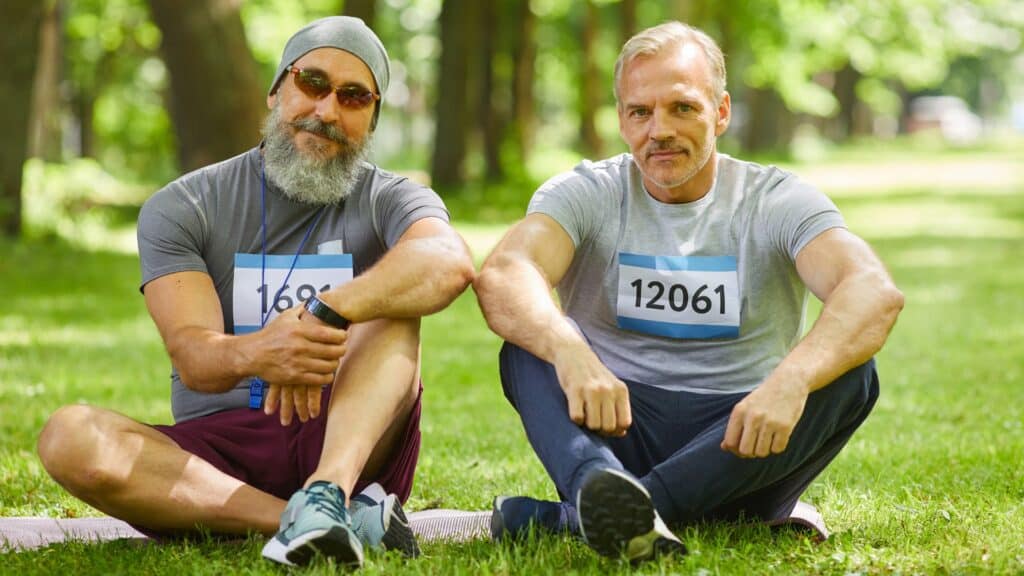Running is an excellent form of exercise that provides numerous benefits for people of all ages, but it is especially beneficial for people over the age of 50.
Running improves cardiovascular health, strengthens bones, improves balance, and enhances mental well-being. However, as we age, our bodies change, and our running technique may need to be adjusted to avoid injury and ensure that we continue to enjoy our running.
Recovery is an important technique after running. It helps the body recover from the stress caused by exercise. To recover well, make sure to get enough rest, stay hydrated, and eat nutritious food. These practices can help your muscles heal and improve your running performance over time.
Below, we will discuss the essential running techniques that runners over 50 should know to ensure they get the most out of their running experience.

Which Running Strategies Are Suitable for Runners Over 50?
Running is a great way to stay healthy and active, regardless of age. However, adjusting your running techniques to reduce the risk of injury and maximize your exercise is important as you age.
With the following techniques, runners over 50 can continue to enjoy the many benefits of running for years to come:
- A Mindset Shift
- Adjust Your Performance Targets
- Recovery and Training Adjustments
- Gender Differences in Athletes Over 50
- Don’t Compare Yourself To Your Younger Self
- Enjoy the Fact That You’re Still Moving Forward
- Incorporate High-Intensity Interval Training (HIIT)
- Changes in Training Principles
- Do Strength Training
- Listen To Your Body
- Respect Your Limits
- Good Postural Alignment
A Mindset Shift
Albert Einstein once remarked that repeating the same actions and expecting different outcomes is a form of insanity.
We suggest accepting the changes that come with aging and letting go of the accomplishments from your younger days. It can be tough for runners over 50 to admit they’re getting older and to give up what they could do in their 20s.
Adjust Your Performance Targets
Let go of chasing personal records from your younger days. Instead, aim for your best performance each season and adjust your goals accordingly. Instead, set new targets every year and focus on being the best version of yourself based on your current fitness level.
Recovery and Training Adjustments
Acknowledging the impact of aging, we want to highlight how crucial it is to take breaks during your workouts. We recommend going at a steady pace to avoid getting overly tired and to stay away from injuries.
Additionally, we strongly suggest planning rest days thoughtfully in your weekly workout schedule. These rest days are important because they give your body the time it needs to recover and become stronger, especially considering that recovery takes a bit longer as you age. Remember, taking it easy isn’t just resting; it’s a key part of your overall training plan.
Gender Differences in Athletes Over 50
Athletic performance tends to decline before age 40, regardless of gender.
Staying active is crucial for both genders, but nutritional needs vary with age and gender. Men over 50 may experience a loss of muscle strength, tone, and energy. The best multivitamins for men over 50 should include essential minerals like calcium, vitamins, and omega-3s in optimal amounts to counteract these effects and enhance performance.

Women over 50 commonly face issues such as decreased bone density and muscle mass due to lower estrogen and progesterone levels. Female runners should increase their calcium, protein, and vitamin D intake to counteract these effects and prevent injuries as they age.
Discover how you can run better as you get older, without training more or harder than you currently are, all while avoiding injury so that you can run well (and faster) into your 50’s, 60’s & beyond.
Save your seat in our FREE Masterclass here.
Don’t Compare Yourself To Your Younger Self
As we age, it’s common to look back at our past running accomplishments and try replicating them. However, this can sometimes be counterproductive and lead to disappointment and discouragement.
Accepting our current physical abilities and setting achievable goals is important. Each accomplishment should be celebrated, and it’s important to remember that running is a personal journey, not a competition.
We can continue improving and maintaining a healthy and fulfilling running practice by focusing on our progress and enjoying the process.
Enjoy the Fact That You’re Still Moving Forward
It’s worth acknowledging that running is an impressive feat regardless of your age, and you should feel a sense of pride in yourself for continuing to do it.
Instead of dwelling on the challenges and limitations that come with aging, focus on the pure enjoyment and therapeutic benefits of running. Shifting your mindset in this way can help you discover a renewed sense of motivation and drive to pursue your running goals.
Incorporate High-Intensity Interval Training (HIIT)
Adding High-Intensity Interval Training (HIIT) to your workout routine positively affects bone health and muscle mass. HIIT includes short bursts of intense exercise alternated with periods of rest or lower-intensity activity.
Studies have demonstrated that engaging in high-intensity interval exercises promotes bone density, a crucial factor, especially for aging athletes. With age, bone density tends to decrease, making bones more vulnerable to fractures and injuries.
Furthermore, we want to emphasize the importance of adding resistance training to High-Intensity Interval Training (HIIT), especially for female athletes. It’s recommended to do exercises with body weight or resistance bands, highlighting how crucial these activities are for preserving muscle mass and overall strength.
The reason behind this suggestion is to counteract the natural loss of lean muscle mass that happens as we age. This, in turn, contributes to an improvement in overall physical performance.
Making sure you do the correct strength training is important. The good news is we’ve created a free strength training plan for runners that you can download by clicking here.
Changes in Training Principles
As we get older, it’s essential to adjust our training principles. We recommend a more focused and specific approach, acknowledging that what worked in our younger years may not be as effective now.
We stress the vital role of strength training, highlighting its critical function in counteracting the natural decline of lean muscle mass over time.
Strength training is not an optional addition but an essential component to maintain and improve physical capabilities.
Do Strength Training
As a runner, you may already know that strength training is an important part of your routine. However, did you know that as you age, the importance of strength training only increases? It’s because as we get older, our bodies naturally lose muscle mass and strength, making us more prone to injury.
That’s why incorporating strength training exercises that target muscle groups not activated while running is crucial to maintaining power and stability.
Incorporating strength training into your routine has many benefits. First and foremost, it can help you avoid injuries. When you engage in strength training, you strengthen the muscles and connective tissues that support your joints, reducing the risk of injury from the repetitive stress of running.
Additionally, strength training can help you maintain your running stamina as you age, allowing you to continue running for longer.
Listen To Your Body
One of the most important techniques for runners of any age is to listen to their bodies. This means paying attention to your body’s feelings during your runs and adjusting as needed.
If you encounter pain or ongoing discomfort, you must take a break and, if needed, seek professional assistance. Paying attention to your body can prevent injuries and maintain your health while working towards your running objectives.
Respect Your Limits
It is crucial to acknowledge and accept your physical limitations in order to prevent injuries.
Rushing into intense physical activities without proper preparation can put undue pressure on your body and lead to painful injuries. It is important to recognize that your body may not respond to exercise in the same way as it did before and to be mindful of your current limits.

Rather than pushing yourself beyond your capabilities, celebrate the achievements that you can make within your current physical abilities. Doing so can improve your overall health and reduce the risk of injury.
Good Postural Alignment
Maintaining good postural alignment is of utmost importance for a healthy body. Good posture enhances breathing, prevents slouching, and also helps to keep the spine in its natural curve. When it comes to running, maintaining a straight and relaxed upper body is crucial for efficient movement.
One technique to ensure good postural alignment is standing against a wall with your heels, buttocks, shoulders, and the back of the head touching the wall. This technique can help you become aware of your postural habits and correct them over time, improving your overall health and well-being.
Acceptance and Action
It’s crucial to highlight the importance of acknowledging and embracing the inevitable changes that accompany aging. Recognizing and accepting the reality of growing older is a fundamental aspect of an athlete’s journey.
This is especially true when considering the emotional challenge, particularly for individuals who may struggle to let go of their past athletic achievements.
The aging process goes beyond mere acknowledgement; athletes need to be ready to take concrete actions to adapt and optimize their performance given the new circumstances.
It’s not just about understanding that things are different; it’s about actively seeking ways to navigate these changes and continue progressing despite the natural limitations that come with aging.
This involves a proactive approach to maintaining a positive athletic journey despite the evolving circumstances.

FAQ: Running for Runners Over 50
Is Running Good For Over 50s?
Absolutely! Running in your 50s is an excellent way to keep your heart healthy and your body strong. It also reduces the risk of dementia, cancer, diabetes, and depression.
Is 50 Too Old To Run A Marathon?
You’re never too old to run a marathon! You just have to take the time to prepare properly, and your recovery time might be a little longer than that of a younger runner. With the right training, including following the tips in this article, you can absolutely tackle your first marathon in your 50s! Just be sure to get your doctor’s approval before you start any training program.
Is Running More Difficult for Runners Over 50?
There’s no question that the natural aging process takes a toll on our bodies, and that can make running into your senior years a bit more challenging. In your senior years, you are at greater risk of things like a runner’s knee, Achilles tendon pain, shin splints, and stress fractures.
If your doctor gives you the green light and you follow the steps in this article, the risks are significantly minimized. It’s essential to remember that you don’t have to commit to running a marathon or even a 5K to enjoy the benefits of running. Running for fun remains one of the best forms of cardiovascular exercise at any age!
Running is a fantastic way to maintain physical and mental health at any age. However, as we age, using the appropriate running strategies can help us maintain our safety and achieve our running goals. Older runners can safely and effectively enjoy the many benefits of running through rest, strength training, and balancing their workouts.
Remember to focus on what your body can do, be patient and kind to yourself, and invest in the right gear to keep your running journey a positive and wholesome experience. So, go on and enjoy yourself!



Comments are closed.